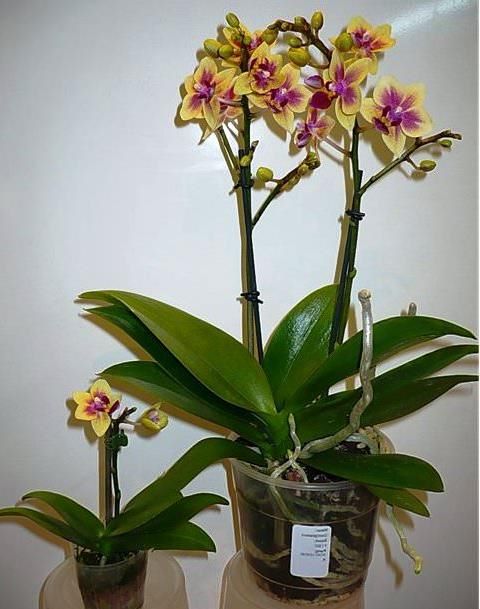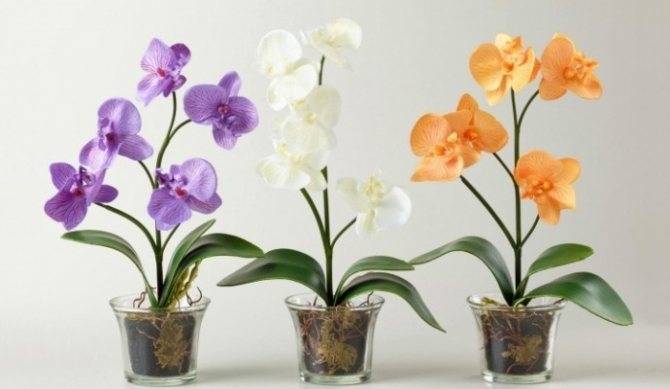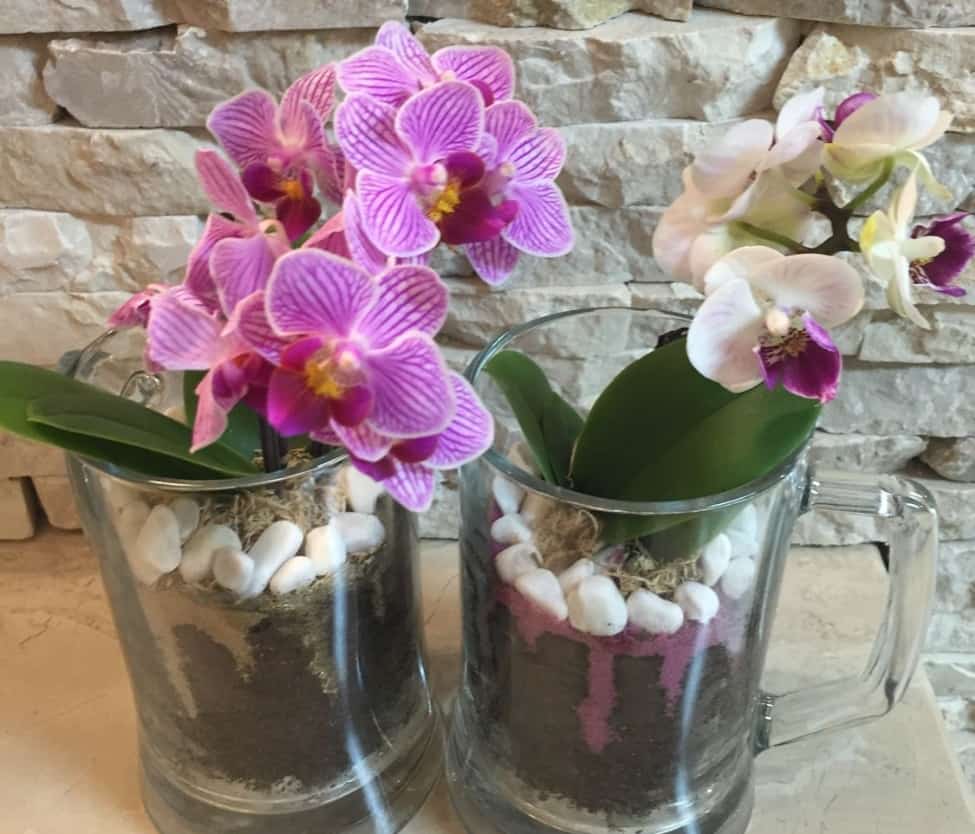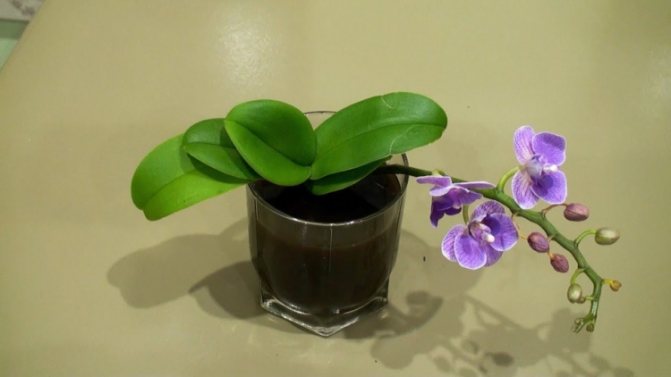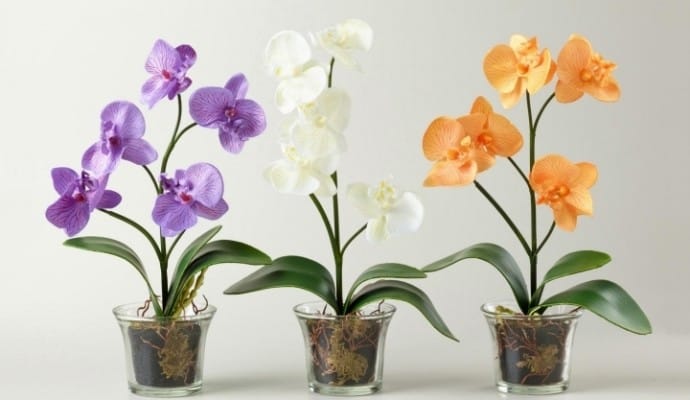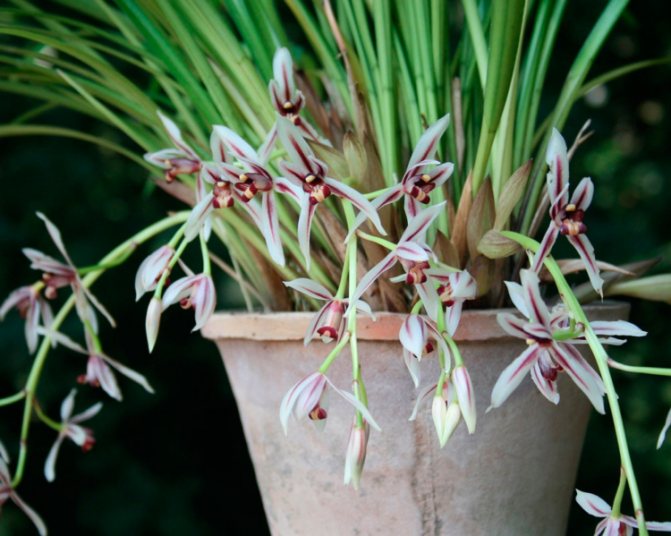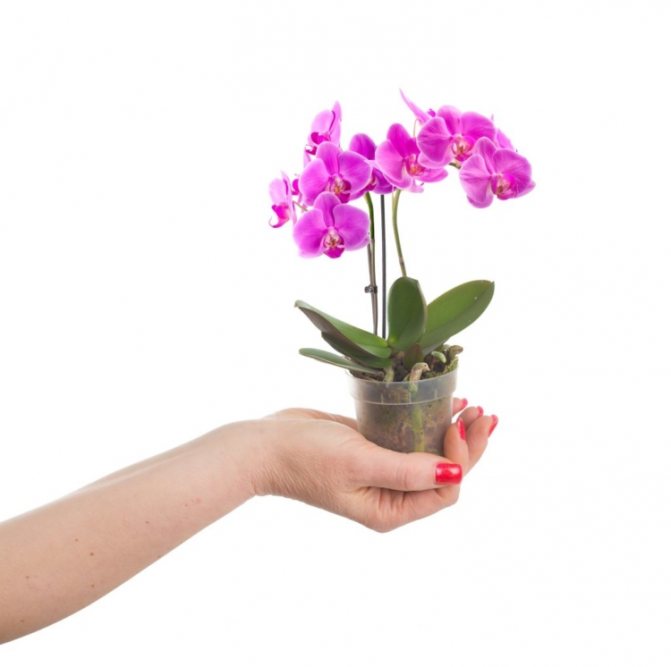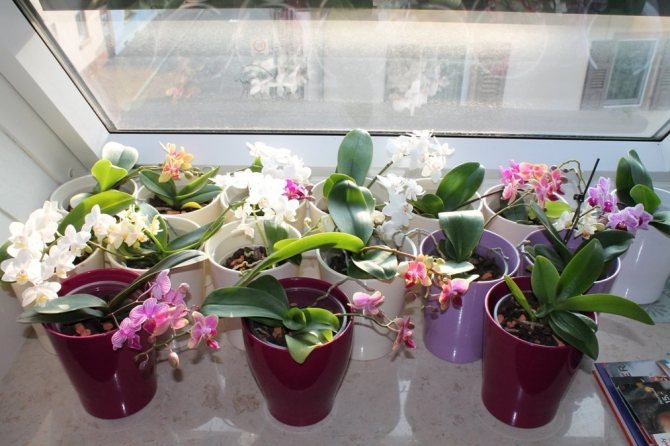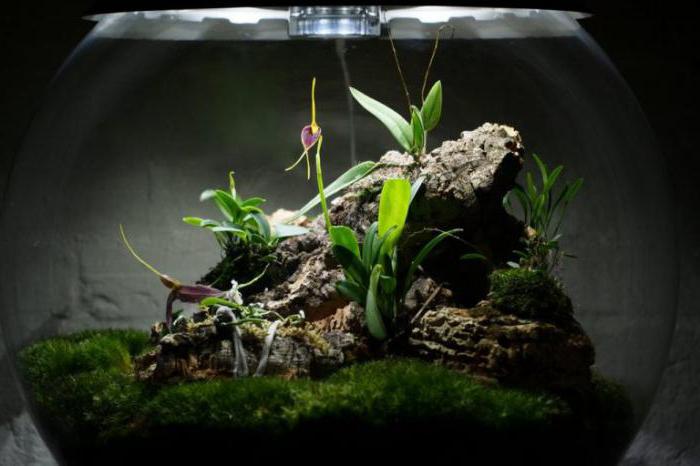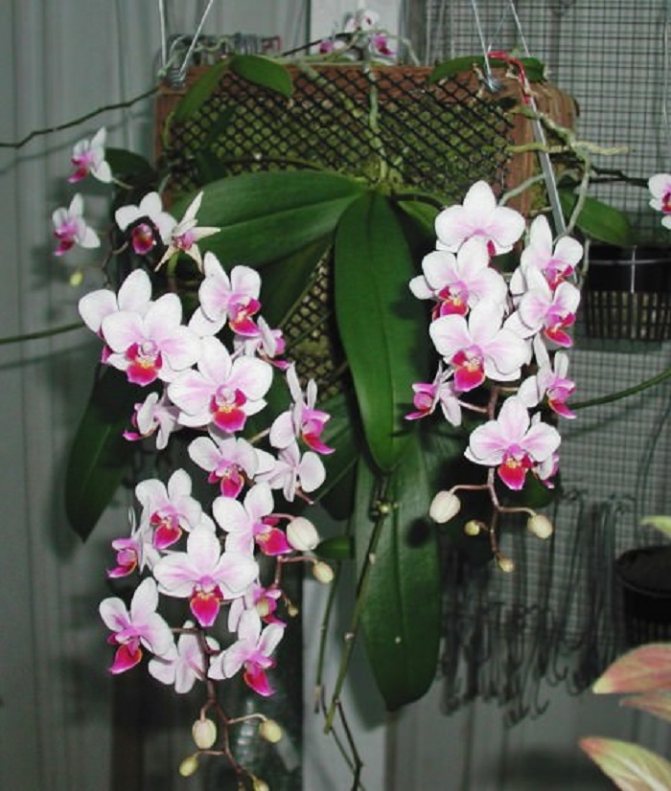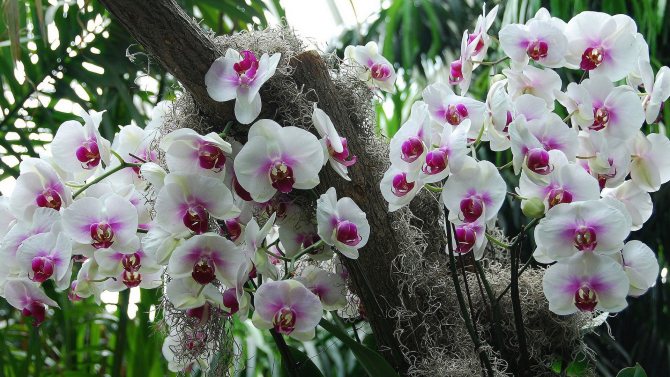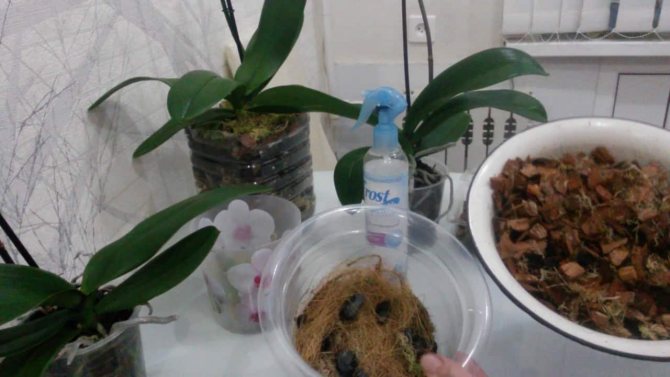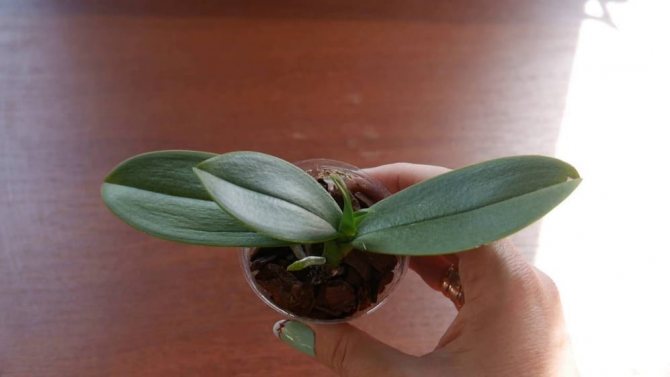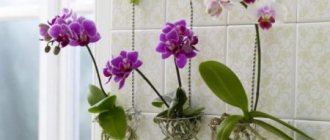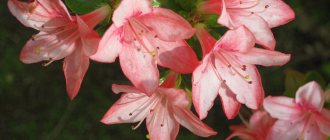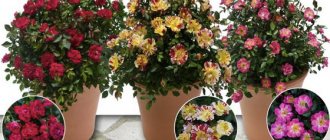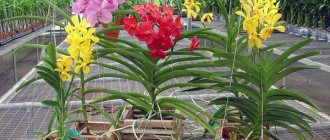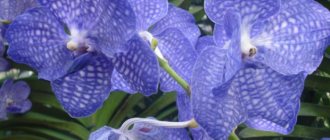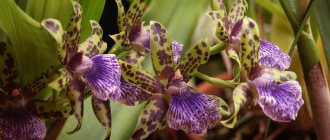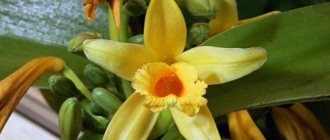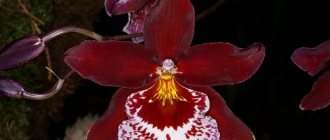Plants »Flowers
0
5288
Article rating
miniature orchid varieties are bred by selection. These are low-growing plants that grow up to 15 cm in height. Mini phalaenopsis is a dwarf species with branched peduncles. The orchid blooms twice a year. Crop maintenance is minimal: irrigation, soil fertilization and proper lighting.
Phalaenopsis mini orchid home care
Description of the plant
The dwarf orchid, or mini phalaenopsis, has long been a houseplant in eastern countries. Therefore, it is not known where small copies of tall plants were first bred. Two countries claim the title of the homeland of this flower at once: China and Japan.
A small orchid forms a small bush of leaves, the length of which varies between 10-15 cm. They are painted in a rich green color. In spring, the plant forms a long peduncle on which flowers form. The diameter of each is 3-4 cm. The color of the petals depends on the variety. Look at the photo below - how charming the mini orchid looks during flowering, which lasts up to 6 months.
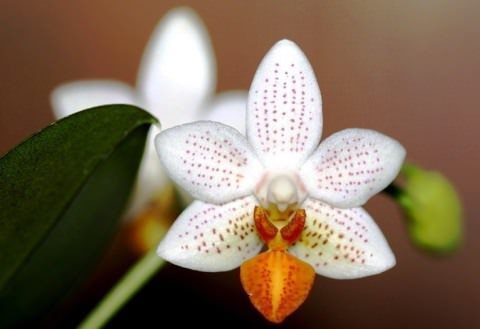
Mini phalaenopsis is the same orchid. However, it rarely reaches a height higher than 15 cm. It is grown in miniature pots and used to decorate the interior of an apartment (see photo).
Description and characteristics of the mini phalaenopsis flower
The home dwarf orchid Phalaenopsis is native to Southeast Asia, the Philippines and northern Australia. In its natural environment, this species grows in tropical forests.
The size of this attractive little plant does not exceed 20 cm in height, and pots should be selected for it, taking into account the miniature dimensions.
The flower is broad-leaved, has a short stem. Leaves grow only vertically upwards. Aerial roots may form, growing from the leaf axils. Like the rest of the Phalaenopsis species, the flowers of this plant are similar in appearance to a butterfly.
Choice of place and conditions of detention
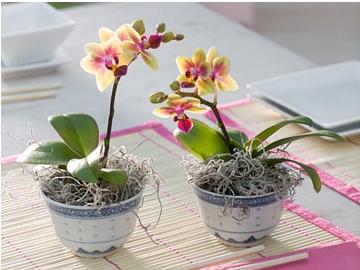

In order for a miniature orchid to grow healthy, bloom for a long time and abundantly, it must be kept under conditions suitable for it. Let's find out what the microclimate and care of the dwarf phalaenopsis should be.
Lighting and location
The orchid is a finicky plant. She is very light-requiring, and daylight hours for her should last at least 10-12 hours a day. Otherwise, the flower may simply not bloom. But if you put it under the direct scorching rays of the sun, it will be even worse: the leaves will droop, and the roots will "cook". The only way out is to place the pot in a well-lit place with diffused light. The best option is an east window, or southeast or south, provided you create light shading.
In late autumn, winter and early spring, daylight hours are very short, and the sun's rays are not intense enough. Therefore, dwarf orchids need additional lighting. Ideally, if you supply special phytolamps. A budget, but lower quality option is fluorescent lighting.
The orchid can be placed on the balcony if it is glazed and there is no draft on it. The flower can be left there in winter, if the room is well insulated.
Temperature
Dwarf phalaenopsis varieties like to grow at a temperature of + 18 ... + 25 ° C. It is advisable not to allow the temperature to rise to +30 ° C and above.Intense heat can cause loss of buds or complete death of the plant.
In winter, the orchid is dormant. At this time, she will be comfortable at a temperature of + 15 ... + 20 ° C.
Air and humidity
Orchids are moisture-loving plants. The optimum level of air humidity for them is 60-80%. In summer, this humidity is maintained independently, and in winter the air in the apartments is very dry. A guest from warm countries suffers from this no less than from drafts. Such procedures as wiping and spraying the leaves are very useful for her.
Soil and pot
The living conditions for a regular and dwarf orchid are the same. But they need different soil. Although these flowers do not grow in the ground, but in the substrate. If an ordinary phalaenopsis prefers to grow in pieces of bark, then a miniature copy of it loves to live in moss. Sometimes sphagnum is mixed with highly crushed bark.
Dwarf orchids are planted in small pots: their diameter ranges from 7-9 cm. Both plastic and clay containers are suitable for them. Plastic retains moisture better, and clay allows air to pass through. Both are equally important for a flower.
Advice! Plant your orchid in a clear-walled pot. This will allow the sun's rays to reach the root system. This is very important, since phalaenospis is one of the few plants, in the roots of which photosynthesis occurs in the same way as in the leaves.
Flowering time and dormant period
Phalaenopsis care will largely be determined by the state in which the flower is located: dormancy or flowering. Under natural conditions, the orchid does not have a dormant period; it is able to give flowering all year round. In the climatic conditions of European countries, the flower, due to the change in temperatures and the lack of proper light in winter, does not have the opportunity to develop and grow throughout the year, therefore, it regularly goes into a dormant phase.
A mini orchid can bloom several times a year. After the buds open, the stem must be fixed with a bamboo stick in order to reduce the load on it. In addition, during this period, it is necessary to provide the culture with a sufficient amount of fertilizers, lighting and moisture, as well as to protect it as much as possible from stress, drafts, and sudden temperature fluctuations.
Planting mini orchids


The order of planting miniature phalaenopsis:
- Prepare the pot: scald it with boiling water to destroy pathogenic microflora, or treat it with a solution of potassium permanganate.
- Pour some bark or moss at the bottom.
- Place the plant in a pot and spread its roots.
- Fill the empty spaces between the roots and sides of the container with moss or a mixture of bark and moss.
- Moisten the substrate well.
Place the pot in a shaded area. In the first 3-4 days, the plant must be protected from an abundance of light, so that the adaptation period of its adaptation passes faster.
Watering orchids on a moss "pillow"
These need to be watered more often than those growing in the bark, but less water is needed.
Moss has a higher moisture capacity than bark: it absorbs 25 times more water than it weighs. This is achieved thanks to empty, unclosed cells that fill with liquid in a short time.
So watering a mini-orchid growing in moss by dipping or spilling is fraught with too high moisture in its soil.
So here it is recommended to spray the ground a couple of times a day. Well, or pour from a spoon - from the dining room or tea room, depending on the size of the pot. This amount of water will dissipate throughout the moss in a short time.
In case of prolonged irrigation of an orchid for several days, its leaves become slightly wrinkled. Then the plant must be watered using any of the methods described above. If the reason for the wrinkling was precisely the lack of irrigation, the shape of the leaves will be restored.
But if it does not recover, it means that the roots of the plant have died. Then it is necessary to urgently carry out its resuscitation and build up a new root system.
Care
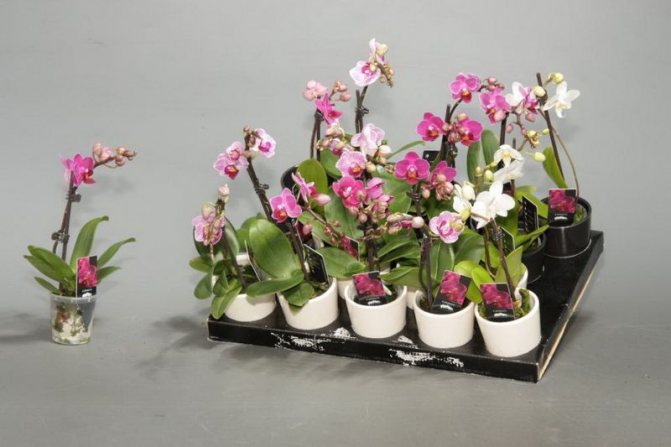

Caring for home-grown dwarf orchids is not the most difficult. But the mini phalaenopsis cannot be called unpretentious.
Watering
The orchid loves moisture very much, but you need to give it as much as it needs. It is worth pouring the plant, and the roots will immediately rot: they are very susceptible to fungal diseases. You need to water it every time the substrate dries up. If it is dry, the pot will make a ringing sound when tapped.
It is best to moisten the substrate not with regular watering, but by immersing the pot in a container of water for 30-40 minutes. Then the flower itself will absorb through the drainage holes as much water as it needs. If you water in the standard way, then after the procedure, be sure to wipe the leaves. For humidification, water that has been settled during the day is suitable.
Advice! In winter, water the orchid as often as in summer. The frequency of moistening the substrate is reduced only if, along with this, the air temperature decreases (it stably remains at a level below +18 ° C).
To remove dust from the leaves, the orchid should be wiped with a soft cloth or sponge dipped in water. For this, it is also convenient to put the flower under a hot shower: Phalaenopsis needs it once a month.
Top dressing
During the period of active growth and flowering, dwarf phalaenopsis are fertilized every 2 weeks. But feeding is done not by root, but by sheet method. For this, complex fertilizers are used, intended for ordinary orchids. But take for this only a fourth of the granules. They are diluted in water and the leaves are sprayed with the resulting solution. Although some growers pour it into a pot. However, this is dangerous if the pot is transparent: the roots can burn.
Advice! In winter, during the dormant period, the plant can not be fertilized. Especially if the room temperature remains low.
Loosening, mulching
Mini orchid substrate does not need loosening and mulching. It is already very light and loose. It allows air to pass through well and delivers it to the roots of the plant.
Pinching, pinching, pruning
Dwarf orchid varieties do not need formative pruning and pinching. However, after the end of flowering, the peduncles must be removed by cutting it above the location of the buds.
Transfer
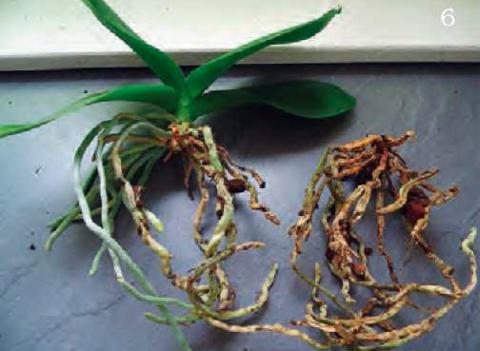

Miniature orchids need replanting every 3 years. This is due to the fact that these plants develop very slowly. In this case, the pot is either left the same, or they take a container with a diameter increased by 1-2 cm. Its width depends on the size of the root system of the flower.
The optimal time for transplanting mini phalaenopsis is early spring. At this time, the plant wakes up, and it will be easier for it to take root in a new pot. Some experts recommend replanting the flower in the fall after flowering ends. However, a diseased orchid can be transplanted at any time of the year, regardless of the presence of flowers.
When the plant is sick, an unscheduled transplant is acceptable. Usually it is performed in case of decay of the root system.
Transplant procedure:
- Prepare a new pot and fresh substrate.
- Place a small layer of moss or finely chopped bark on the bottom of the container.
- Take a pot of orchids and place it on its side.
- Remove the flower carefully.
- Rinse the plant roots in warm water and let them dry for a few hours.
- Examine the root system and remove rotting, darkened and damaged roots.
- Treat the cut sites with wood ash or crushed activated carbon.
- Place the orchid in a new pot and cover the free space with substrate.
- Water the flower and place it on a window with light shading.
Attention! Some growers recommend replanting phalaenopsis immediately after you bring it from the store.However, florists believe that the very change of scenery for a plant is already stressful. If at the same time it is also transplanted, then the flower can get sick and slow down in development. Therefore, it is better to replant it 2-3 weeks after purchase. During this time, he will have time to adapt to new conditions of detention.
general characteristics
Mini orchids, dwarf orchids, they are also phalaenopsis, are flowers belonging to the same species. There are a huge number of varieties and varieties of phalaenopsis. However, we will only consider the mini, or dwarf version.
Mini-orchids are not in vain loved by avid flower growers and people who just want to bring a little coziness to the room. These flowers are miniature in size, which distinguishes them favorably from standard plants.
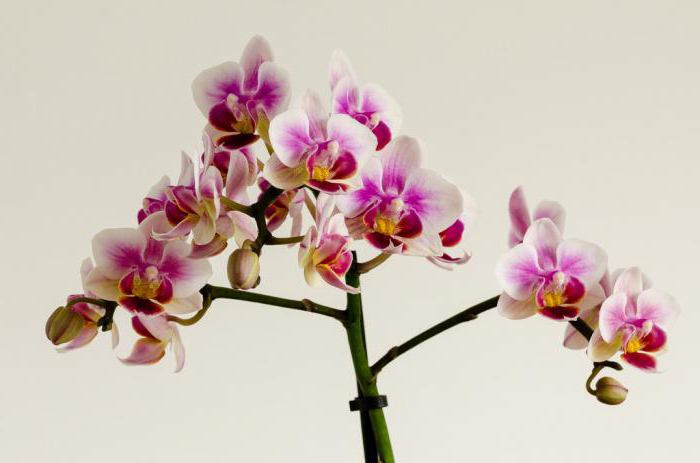

Dwarf orchids come in many varieties. An adult flower, together with an inflorescence, reaches 15-30 centimeters in height. There are varieties that are even smaller - they do not grow taller than 10 centimeters.
Where does this flower grow? A mini-orchid in nature can be found in the vastness of the wooded part of the equator or among the rocks. In order to grow phalaenopsis at home successfully, you need to understand which variety is most suitable for the microclimate of your home.
As mentioned earlier, mini orchid varieties are diverse. But it is impossible to consider all of them, so let's focus on the most popular ones.
Reproduction of mini orchids
At home, miniature orchid varieties reproduce exclusively in a vegetative way. This is done by separating daughter shoots from the mother bush. For this:
- With a sharp knife treated with alcohol, separate the daughter shoot from the bush.
- Treat the cut site with activated carbon crushed to powder.
- Make a greenhouse, on the bottom of which lay a layer of sphagnum. The moss should always be well hydrated.
- Stick the bottom of the young shoot into the moss.
- Place the greenhouse in a warm and well-lit area.
- Ventilate it every day so that the air does not stagnate. Monitor the moisture content of the substrate.
- After some time, several roots will form on the shoot. When they are 2-3 cm long, plant the plant in a permanent pot.
With this method of reproduction, flowering begins in a year.
How to care for miniature orchids
It is impossible to give any general rules for care, since they are all from different genera, which grow in different conditions. Therefore, for each specific species, these will have their own conditions, they are usually given in the description of the species themselves.
Phalaenopsis mini and miniature - what is the difference
But there are 2 rules that apply to all epiphytic orchids.
First, it is good drying of the roots between waterings. Even if the plants are miniature, you should not think that they need more frequent watering or daily spraying.
And secondly, it is the quality of water for irrigation and spraying. Water should be soft - boiled, rain, snow or distilled.
These "crumbs" have already conquered many hearts, their cultivation is very addictive, I want to buy more and more new species. The main thing is not to "love" them to death. Do you have miniature orchids?
- All about orchids
Diseases and pests
Under poor conditions and improper care, orchids get sick and are affected by pests. Most often, plants feast on juice:
- thrips,
- aphid,
- shield,
- mealybug,
- spider mite.
If you find signs of damage to a flower by pests, treat it with an insecticide (Inta-Vir, Aktara). You can also get rid of aphids by washing the leaves and stems of the plant with soapy water.
Among phalaenopsis diseases, root rot is most common. The reason for this is the systematic waterlogging of the substrate and poor drainage. In this case, it is necessary to transplant the flower into a new pot with a new substrate.Before planting, remove all rotten roots and treat them with a 0.2% Fundazole solution.
Resuscitation
Orchid resuscitation possible in two ways: outdoors and in a greenhouse... The choice of method depends on how much the roots are damaged. If all the roots have rotted, then the greenhouse method is preferable. In the event that there are whole roots left, then it is better to choose the first option. The process can take one month or one year, it all depends on the scale of the problem.
In order to prevent such consequences, the reasons should be eliminated at the moment of their appearance:
- With an excess of water or light, the plant may have yellowness on the leaves.
- Too high temperature and low humidity can lead to early drop of flowers.
- Leaf decay is a sign of improper care of them.
- When the roots lack moisture, they shrivel and darken.
Advice
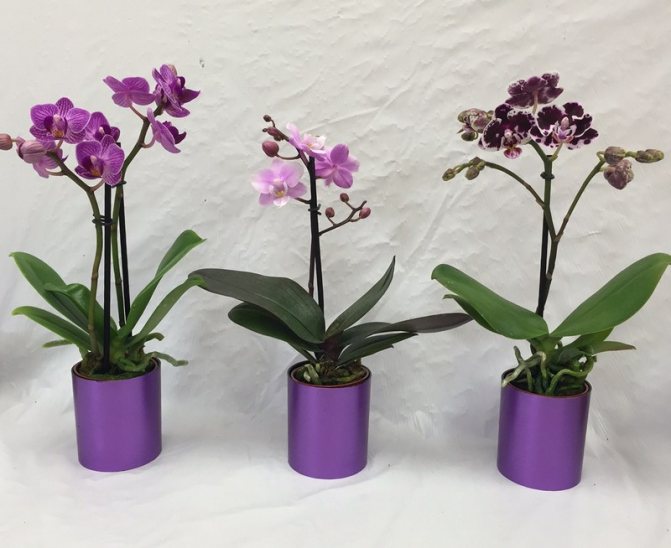

Experienced growers give the following tips:
- If the leaves of the mini orchid begin to turn yellow with regular watering, reduce its frequency. If the plant doesn't feel better after doing this, transplant it.
- If the leaves turn dark green and begin to wrinkle, the frequency of watering should be increased.
- If buds and flowers fall off, make sure that the air temperature does not exceed 30 ° C, and the air humidity does not fall below 50-60%. Try to create optimal conditions for the mini phalaenopsis.
- If the leaves are rotting, you are most likely watering the flower incorrectly or not wiping the shower leaves off. It is important for an orchid that after water procedures the leaves become dry as soon as possible. Therefore, they must be wiped with a dry cloth. Pay special attention to the space between the shoots.
So far, a mini orchid is rarely found on the shelves of domestic flower shops. But it amazes with its diminutiveness and sophistication: it is impossible to pass by it. Plant this miracle on your windowsill, and it will delight you with long flowering from spring to late autumn.
Growing conditions
Growing conditions for mini orchids are fairly standard.
Lighting
Like most orchids, dwarf species prefer bright but diffused lighting. Especially good for them on the windows of east and west orientation. When placing plants on the south side during hot midday hours, they must be shaded.
Humidity
There are no special requirements for air humidity, but the orchid feels most comfortable when the humidity is 50–70%. In drier air, their growth and development can be slowed down. The higher the ambient temperature, the higher the humidity should be.
Advice! To saturate the ambient air with moisture, you can use special air humidifiers or simply place the plants on pallets with wet expanded clay.
Temperature
The ideal temperature for growing mini orchids is 18 to 21 ° throughout the year. At the same time, it is desirable that the night temperatures be several degrees lower than the night ones. Such drops contribute to a more abundant and long lasting flowering.
Substrate
As a substrate for growing mini orchids, pure sphagnum moss is most often used. It can be purchased at specialized flower shops. You can also use a mixture of pine bark with moss. To prevent the development of various rot, it is recommended to add a small amount of charcoal to it.
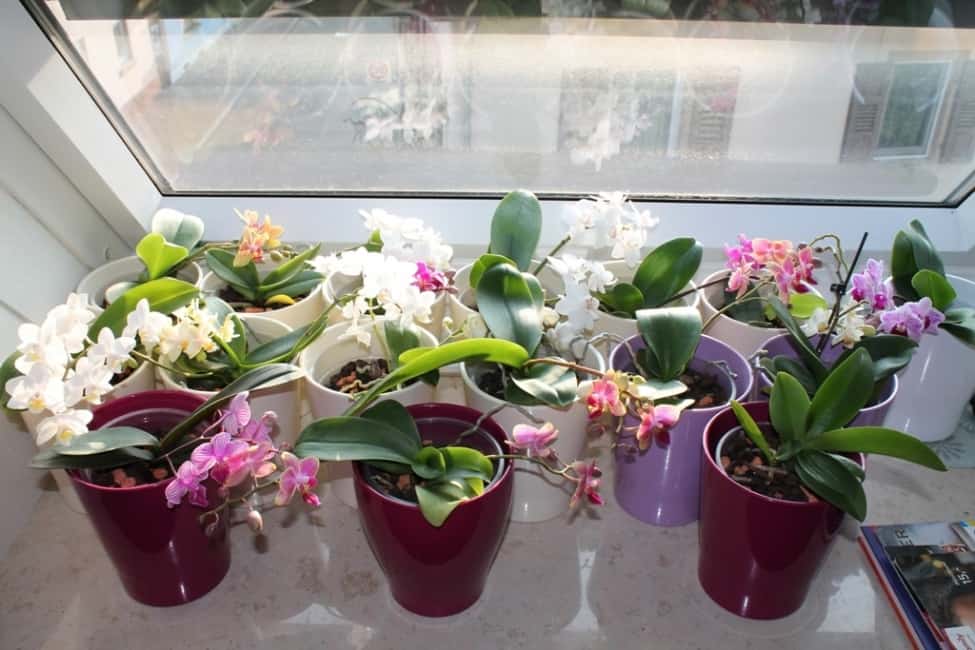

Types of dwarf phalaenopsis
New types of mini orchids appear every year. Most often, their main difference lies in the rich color range and the length of the flowering period. For example, the Mini Mark orchid is especially popular with flower growers. It is a cross between a natural species and Phalaenopsis Micro Nova. For Mini Mark, the characters are saturated green leaves of medium size no more than 15 cm long.The flowers of this hybrid are white in color with an expressive yellow or pink speck and a yellow-brown lip. Their size ranges from 3-4 cm.
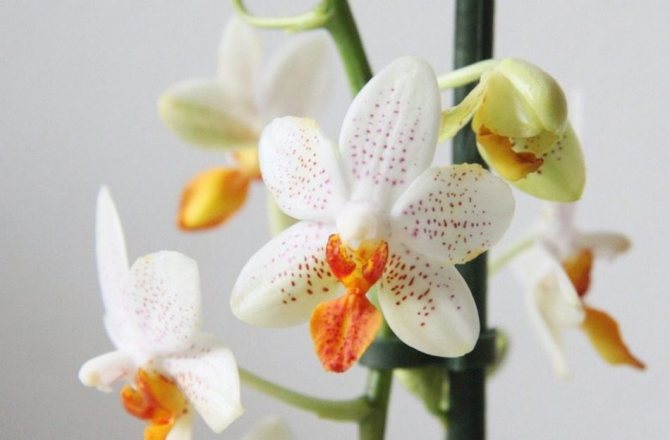

Possible problems and difficulties
For the most part, miniature orchid varieties are unpretentious in care. Of course, like all plants, they can be exposed to some diseases or be affected by pests. In such cases, it is necessary to take appropriate measures to combat these ailments.
The most effective means here will be processing flowers with special compositions and fertilizing with fertilizers.
Mini orchids are a wonderful decoration for home furnishings. They can be used as elements of interior decor, and are often presented as an original gift.
If you find an error, please select a piece of text and press Ctrl + Enter.
Lyrical digression, or a little about the history of orchids
So, you received an orchid as a gift ... Don't forget to ask her name. If there is no sign (tag, memo) with its name.
And you start to get acquainted with the gift. This acquaintance will open up a whole world of orchids.
They are affectionately called Orhochki. Phalaenopsis is a little more difficult to pronounce. The history of their appearance and development is amazing. Information about their existence sends us back three thousand years. Even then, they were the subject of admiration. Some of them no longer exist. But many new ones have appeared.
And what do we know about them:
- Georg Rumph was the first to tell about the amazing flowers he saw in the Moluccas. This was in the seventeenth century;
- In the book "Plant Species" Karl Liney called these flowers an adorable epidendrum;
- Phalaenopsis is from Karl Blume. During his expedition, he confused them with moths. And they began to compare them with moths;
- And this was not the last title. Meet the following names:
- Doritis;
- Kingiella;
- Grafia;
- Lesliea;
- Sunadena;
- And not only. After all, their only more than 70 species;
- And many varieties do not have a permanent name in Russian.
In natural conditions, they are well known to the inhabitants of Southeast Asia. Places are warm and humid. In the mountains and plains. The southern regions of China are even considered a homeland.
And here they do not grow on the ground. They are epiphytes - plants growing on other plants. They are called forophytes.
The same Karl Linney from 1753 laid the foundation for the systematization of orchid species.
BUT today the exact names are available to specialists. And also, the so-called orchidists. For amateurs and beginners interested in these plants, a different list is applicable.
It is also called consumer classification. According to her Phalaenopsis varieties are divided according to the type of flowering. Let's get to know them:
- Standard:
- The flowers are large (up to 12 cm). They grow in the upper part of long peduncles;
- After flowering, the apical bud dies off.
- Novelty:
- Small flowers (3-8 cm) are placed on a peduncle growing from the upper bud;
- They can be both classic (from natural species) and modern.
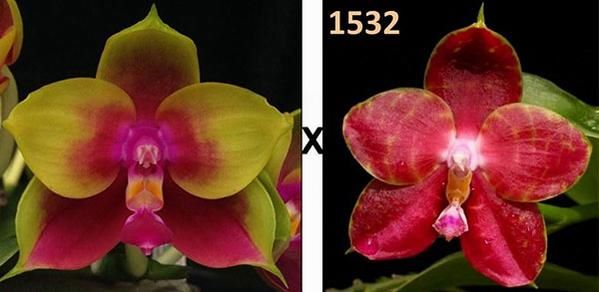

Phalaenopsis Pylo's Novelty.
But the sellers and distributors of these colors use the commercial classification. They are interested not only in the size of the flower, but also in the size of the entire plant. Larger leaf sizes, more flowers - and it costs more. Even though the size of the flowers is the same. As a selling branch of mimosa before March 8th. The larger, the more expensive.
